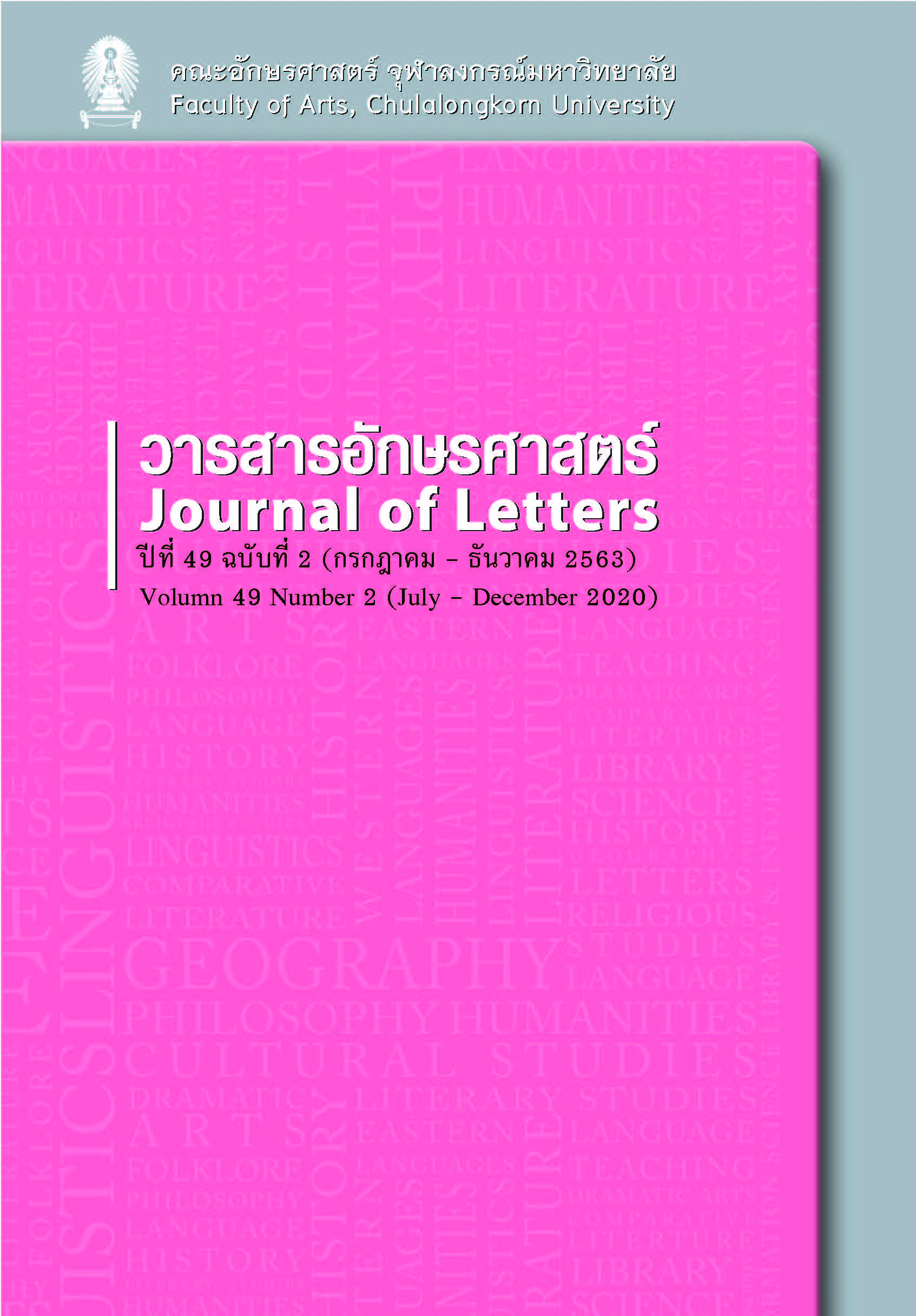Friendship Across Ethnic Boundaries in John Boyne’s The Boy in the Striped Pajamas and Daniella Carmi’s Samir and Yonatan
Keywords:
Friendship across ethnic boundaries, Racial discrimination, Holocaust, The conflict between Palestine and Israel, and WarAbstract
This paper examines friendship across ethnic boundaries in two young adult novels: John Boyne’s The Boy in the Striped Pajamas and Daniella Carmi’s Samir and Yonatan. In the first novel, the author recounts a story of the Holocaust during the Second World War while the latter deals with the conflict between Palestine and Israel. Although both young adult novels concern different ethnic backgrounds, they are both set in the midst of conflicts and wars between two nations. They present themes of crossing over ethnic boundaries and rejection of racial prejudice and violence. Although it seems that both authors create an ideal world for young adult readers to enjoy, Carmi implicitly presents the theme of racial difference in her novel by showing how Samir, a Palestinian boy learns to co-exist with the Israelis through the guidance of Yonatan, an Israeli boy, on a path toward peace. Such a narrative suggests that if Palestinians learn to live with the Israelis, their conflict will come to an end. The Boy in the Striped Pajamas features a friendship between Bruno, the son of a Nazi soldier, and Shmuel, the son of a Jew. Bruno disobeys his father’s command by secretively exploring the concentration camp. This gives him a chance to befriend Shmuel. However, Bruno keeps this friendship secret. Finally, this relationship ends tragically when the boys die in the concentration camp. Their concealed friendship can be interpreted as pointing to the impossibility of friendship between Nazis and Jews.
References
ภาษาไทย
Chutima Prakadwuthisarn ชุติมา ประกาศวุฒิสาร. 2011. Korang Sangrueng: Ruenglao Attalak lae Chumchon nai Wannakam Satri Chaikob ก่อร่าง สร้างเรื่อง: เรื่องเล่า อัตลักษณ์ และชุมชนในวรรณกรรมสตรีชายขอบ [Story Creating: Narratives Identities and Communities in Marginalised Women’s Literature]. Bangkok: Kobfai.
Darin Praditthatsanee ดารินทร์ ประดิษฐทัศนีย์. 2011. Plodaek Ananikom tang Kwamkid nai Karma Cola: Marketing the Mystic East khong Gita Mehta ปลดแอกอาณานิคมทางความคิดใน Karma Cola: Marketing the Mystic East ของ Gita Mehta [Decolonizing the Mind in Gita Meta’s Karma Cola: Marketing the Mystic East]. Varasarn Aksorasat Mahawittayalai Silpakorn วารสารอักษรศาสตร์ มหาวิทยาลัยศิลปากร [Journal of the Faculty of Arts, Silpakorn University] 33(1): 105-140.
Nantana Kapilakan นันทนา กปิลกาญจน์. 1998. Prawattisat Tawan-ork Klang nai Lok Patchuban ประวัติศาสตร์ตะวันออกกลางในโลกปัจจุบัน [Middle Eastern History in Contemporary World]. Bangkok: Odien Store.
Siriporn Sriwarakan ศิริพร ศรีวรกานต์ 2012. Kantitham rawang Kon Tang Wattanatham nai Hin Thi Pleng Siang kong Ghazi Abdel-Qadir ขันติธรรมระหว่างคนต่างวัฒนธรรมในหินที่เปล่งเสียงของฆอซี อับเดล-เกาะดีร [Intercultural Tolerance in Ghazi Abdel-Qadir’s Die Sprechenden Steine]. Varasarn Aksorasat Mahawittayalai Silpakorn วารสารอักษรศาสตร์ มหาวิทยาลัยศิลปากร [Journal of the Faculty of Arts, Silpakorn University] 34(2): 88-112.
ภาษาต่างประเทศ
Abdel-Qadir, Ghazi. 1998. Die sprechenden Steine. Weinheim: Beltz & Gelberg.
Ariés, Philippe. 1962. Centuries of Childhood: A Social History of Family Life (Robert Baldick, Trans.). https://archive.org/details/centuriesofchild00arie
Ashcroft, B., Griffiths, G., & Tiffin, H. 1989. The Empire Writes Back: Theory and Practice in Post-Colonial Literatures. London: Routledge.
Auschwitz-Birkenau [Online image]. (n.d.). https://earthtrekkers.com, accessed October 29, 2019.
Boissoneault, Lorraine. 2018. “A 1938 Nazi Law Forced Jews to Register Their Wealth—Making It Easier to Steal.” https://www.smithsonianmag.com, accessed October 29, 2018.
Boyne, John. 2006. The Boy in the Striped Pajamas. New York: David Fickling Book.
Brunken, Otto. 2002. Kinder-und Jugendliteratur von den Anfängen bis 1945: Ein Überblick. In Taschenbuch der Kinder- und Jugendliteratur (3rd ed., Vol. 2), ed. Günter Lang, 17-96. Baltmannsweiler: Schneider.
Carmi, Daniella. 2000. Samir and Yonatan (Yael Lotan, Trans.). New York: Scholastic Signature.
Furies (n.d.). https://www.britannica.com, accessed October 29, 2018.
Galton, David J. 1998. Greek Theories on Eugenics. Journal of Medical Ethics 24(4): 263-267.
Hegg, Ashlyn S. 2013. “Crossing the Line: A Discussion of Motives Within the Boy in the Striped Pajamas.” Master’s thesis, Southern Illinnois University, Carbondale.
Milton-Edwards, Beverley. 2009. The Israeli-Palestinian Conflict: A People’s War. London: Routledge.
Propp, Vladimir. 2009. Morphology of The Folktale (20th ed.). Austin: University of Texas Press.
Said, Edward W. 2001. Reflections on Exile and Other Literary and Cultural Essays. London: Granta Books.
Samir and Yonatan [Online image]. (n.d.). https://www.goodreads.com/book/show/875447. Samir and Yonatan, accessed October 29, 2019.
Schlebach, Andreas. 2020. “Euthanasie: "Rassenhygiene" der Nationalsozialisten.” https://www.ndr.de, accessed November 5, 2020.
Tal, Eve. 2008. ‘From Both Sides Now’: Power and Powerlessness in Two Contemporary Novels of the Middle East. International Research in Children’s Literature 1(1): 16-26. https://www.researchgate.net/publication/250231119 'From Both Sides Now' Power and Powerlessness in Two Contemporary Novels of the Middle East
The Boy in the Striped Pajamas [Online image]. (n.d.). www.gstatic.com/tv/th, accessed October 29, 2019.
The West Bank and the Gaza Strip [Online image]. (n.d.). https://middlebororeviewetal.blogspot.com, accessed October 29, 2019.
The Wiener Holocaust Library. (n.d.). The ghettos. https://www.theholocaustexplained.org, accessed October 29, 2018.
Downloads
Published
How to Cite
Issue
Section
License
Copyright and plagiarism
Authors are responsible for obtaining permission to use copyrighted materials from copyright owners. Authors are responsible for observing requisite copyright law when quoting or reproducing copyrighted materials. Quotations and reproductions of content from other published sources must be accompanied by a reference and all sources should be clearly listed in the references section. Quotations and reproductions of content from external sources without due attribution could be considered a severe infringement of academic conduct and may constitute a legal offence under the Copyright Act of B.E. 2537. Any legal ramifications arising from the infringement of copyright regulations would be the sole responsibility of the author(s).



